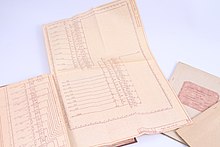This article needs additional citations for verification. (October 2015) |


Whiteprint describes a document reproduction produced by using the diazo chemical process.[1] It is also known as the blue-line process since the result is blue lines on a white background. It is a contact printing process that accurately reproduces the original in size, but cannot reproduce continuous tones or colors. The light sensitivity of the chemicals used was known in the 1890s and several related printing processes were patented at that time. Whiteprinting replaced the blueprint process for reproducing architectural and engineering drawings because the process was simpler and involved fewer toxic chemicals. A blue-line print is not permanent and will fade if exposed to light for weeks or months, but a drawing print that lasts only a few months is sufficient for many purposes.
- ^ Parmeggiani, Fabio (2014). "Fear of the Dark: Diazo Printing by Photochemical Decomposition of Aryldiazonium Tetrafluoroborates". Journal of Chemical Education. 91 (5): 692–695. doi:10.1021/ed400555a. hdl:11311/816119. ISSN 0021-9584.